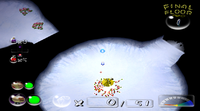Difference between revisions of "Cave unit definition file"
(→Exits) |
|||
| Line 24: | Line 24: | ||
'''Line 2:''' The first of three numbers - <code>dirs</code> - is the direction of the room and player. For example, in the Emergence Cave the direction is <code>2</code>, for all other rooms to connect they must also be <code>2</code>. This value is ''currently'' useless because all rooms must be the same value for them to connect to each other. The player will always face this direction (the camera will oppose), which in a single-door room (any room name with "_1" before the room type) is always towards the next room. | '''Line 2:''' The first of three numbers - <code>dirs</code> - is the direction of the room and player. For example, in the Emergence Cave the direction is <code>2</code>, for all other rooms to connect they must also be <code>2</code>. This value is ''currently'' useless because all rooms must be the same value for them to connect to each other. The player will always face this direction (the camera will oppose), which in a single-door room (any room name with "_1" before the room type) is always towards the next room. | ||
| − | [[File:Dir3.png|200px|thumb| | + | [[File:Dir3.png|200px|thumb|right|An example of <code>dirs</code> set on <code>3</code> while all other room <code>dirs</code> are set on <code>2</code>.]] |
'''Line 3:''' The number of door links. For example, <code>2 # door links</code>. | '''Line 3:''' The number of door links. For example, <code>2 # door links</code>. | ||
Revision as of 15:35, 19 February 2018
In Pikmin 2, each sublevel points to a cave unit list file. These files can be found in /user/Mukki/mapunits/units, and contain a list of units that the game is allowed to use to create the cave with.
Header
After a decorated set of comments that say units definition file comes a line containing the number of units defined in this file. This line is commented with number of units. Each unit's data is defined inside its own block, and conveniently has a comment before it that mentions its name.
Unit
Line 1: The version of the block's data format, this is always 1. For example, 1 # version
Line 2: The internal name of the unit. For example, room_block1_3_tsuchi # foldername.
Line 3: Consisting of two numbers, this defines how many cave grid cells this unit takes up. The first number is for the length in X, the second for the length in Z (y-up). Basically, this means "this unit is X by Z units big". For example, 4 4 # dX/dZ ; cell size.
Line 4: The type of unit this is. 0 is a dead end, 1 is a room, and 2 is a corridor.
Line 5: The unit's flags. For example, 0 1 # room Flags.
To do: Document the unit's flags.
Line 6: This indicates how many exits this unit has. For example, 4 # num doors.
Exits
Line 1: The exit's index, starting from 0. For example, 0 # index
Line 2: The first of three numbers - dirs - is the direction of the room and player. For example, in the Emergence Cave the direction is 2, for all other rooms to connect they must also be 2. This value is currently useless because all rooms must be the same value for them to connect to each other. The player will always face this direction (the camera will oppose), which in a single-door room (any room name with "_1" before the room type) is always towards the next room.
Line 3: The number of door links. For example, 2 # door links.
Line 4(+): Ddst/door-id/tekiflag; there are as many lines for these three numbers as there are door links (specified in line 3). For example, 849.951904 1 1 # dist/door-id/tekiflag.
